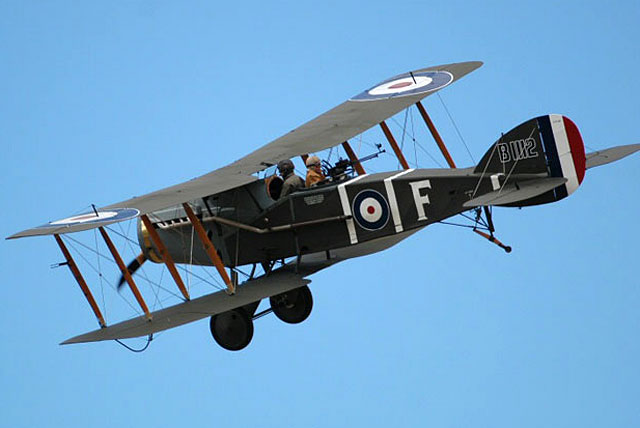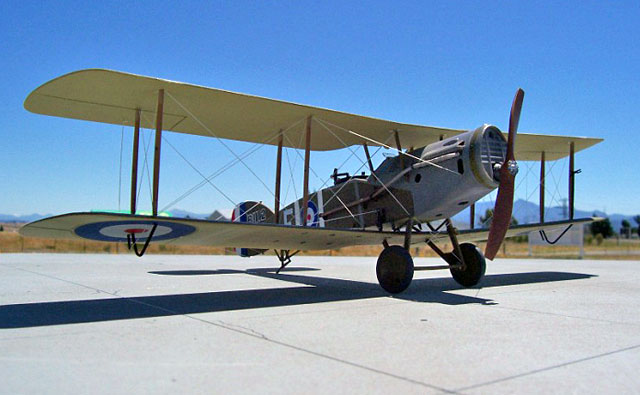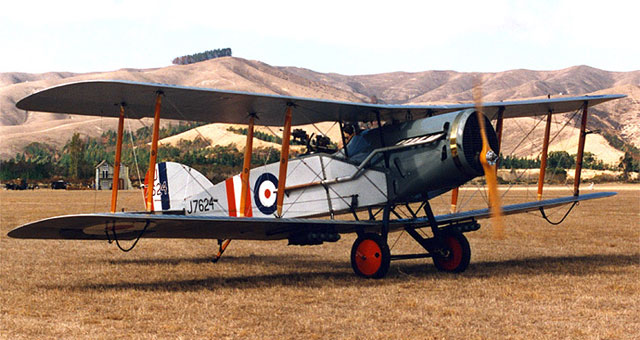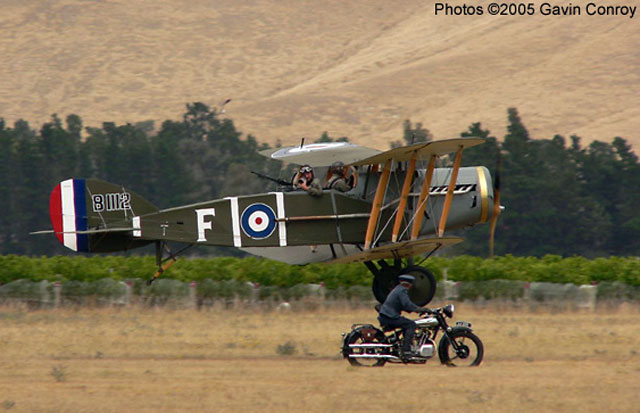|
Bristol F2B Fighter
Flying the Brisfit
by Dave Lochead
|
 |
|
Bristol F2B
Fighter |

Roden's 1/48 scale F2B Fighter is available online
from Squadron.com
Ever wondered what flying a WWI aircraft is like?
This is not a build review of Roden's 1/48 Bristol Fighter kit, as there
are plenty of those around already. Suffice to say that the Roden kit is
beautifully made, a challenge to build, and frustrating to rigÖ You have
been warned.
Six photographs of my 1/48 scale Roden Brisfit kit may be seen below.
Rather, this is an article about what its like to fly the Brisfit,
and my experiences with it. The aircraft I flew was the replica built in
the USA by Ed and Pete Storro, who are currently building a replica
Bristol Bulldog, and now owned and operated by the Omaka fighter
collection.

Click on the thumbnails
below to view larger images of Roden's 1/48 scale Brisfit:
[../../photogallery/photo00032016/real.htm]
Flying the Brisfit
I have to admit to having very little experience with powered
aircraft, my flying has almost exclusively been of the silent type,
Gliders, radio control sailplanes and latterly paragliding, of which I
have managed to amass over 1000 hours experience with no personal
injury, until recently that is. Some time in a Tiger Moth helped prepare
me for what was coming, but not by much.
So while flying is not new to me, being let loose with someone elseís
treasured Great War aircraft was slightly unexpected.
Externally, the replica looks exactly as per the original, however,
internally things are a little different. The Bristol has a welded steel
fuselage instead of the wood, wire and fishplates maze of the originals,
and is fitted with a more modern, but still old, inline six cylinder
Ranger engine and smaller diameter propeller. This is due to the
scarcity of the original V-12 rolls Royce engines. The fitting of modern
engines in WW1 airframes can cause some problems, more of which later
The first impression of the Bristol as you approach it is that its
actually a reasonably large aircraft. Building models of these machines
doesnít prepare you for the first impression you get of the real thing.
I remember thinking how small a Spitfire was when I first saw one, and
how the larger than life legend that surrounds it made me think the
aircraft would somehow be larger that it was in reality. The Bristol on
the other hand, I thought would be small and delicate, just like the
Airfix kit of days gone by.
Prior to flying, a walk around and pre-flight inspection is carried out,
starting at the nose, checking that no birds have snuck in to the
cowling and nested in there.. Iíve never heard of it happening, but I
guess you cant be too sure. Check the prop for splitting, and while we
are here, turn the engine over by the prop about 10 times to get some
oil flowing, naturally before this is carried out, check the Magneto
switches are in the OFF position, embarrassing and messy accidents are
best avoided.
Working our way around the aircraft we come to the ailerons, having
first inspected all struts and fittings for any damage.
It is at this stage I notice two things that do not bode well for the
handling characteristics of this aircraft. Firstly there is no aileron
differential, the effect of the aileron moving further in the up
position than the down, and countering adverse yaw, where the aircraft
rolls one way, and yaws the other due to aileron drag.
Secondly, the aileron gap isnít sealed. This may not sound like much,
but when the airflow reaches the aileron gap, it breaks away and reduces
the effectiveness of the control. I had learnt this lesson the hard way
with radio controlled gliders, and how the roll rate improved when the
aileron gaps were sealed, needless to say I stored this in the back of
my mind to allow for a slower roll rate than the Tiger.
Making our way to the tail area, there are a lot of exposed control
cables to be checked, especially the elevator cables, which cross over
each other and have leather boots to stop them chafing. These cables are
checked very carefully.

The rudder looks impossibly small for the wing span of the aircraft, and
I am starting to realise just how little was known about aerodynamics
and control coupling at the dawn of the warplane. Around to the cockpit,
and we climb up to check all is well. Entering the Bristol is awkward at
best, climbing up over an exhaust pipe. Thankfully cold at this stage,
but not for long, the elevator cables, the scarf ring for the gun in the
rear cockpit, and arranging the straps so you can reach them when
seated.
The only thing to check in the rear cockpit is that the second stick is
fitted, and firmly bolted, and a visual inspection for anything out of
the ordinary. There are no instruments back here, something else I am
going to have to deal with.
Now firmly seated in the cockpit, Tim Sullivan, the Pilot in charge
tells me that we will need to warm the engine, which is quite cold
blooded, and will need 10 minutes of fast idle.
Iím not briefed on any of the checklists for the aircraft, but in this
instance ,its pretty straightforward, cowl shutters closed, throttle
set, stick well back. A couple of turns on the electric starter, a
luxury that WW1 ground crew can only have dreamed of, and the Ranger
springs into life.
The engine is surprisingly quiet, but there is a reasonable amount of
wind buffet, especially in the rear seat, where there is no protection,
and the fabric fuselage sides are drumming from the airflow.
Tim climbs out and leaves me sitting in the aircraft as it warms up, I
realise after a little while that 10 minutes holding the elevator in the
full up position is getting pretty tiring, and the throttle friction
isnít set, so the throttle creeps closed and needs to be adjusted
regularly with the other hand, so a lot of hand swapping is going on to
deal with the fatigue and the throttle problem.
Eventually Tim returns and climbs into the front cockpit, he takes the
stick while I throw his shoulder straps forward, then I take the stick
again as he gets buckled up and comfortable. Comfortable is something
Iím not, as for some reason the rear seat cushion has been overlooked in
all of this operation, and ive been sitting on the hard wood seat pan
with the vibration travelling through my buttocks, and my arms hurt, I
suspect this is some form of initiation ceremony, as Tim is jovially
chatting away unaware of my suffering.
Tim calls for chocks away, opens the radiator shutters, and we throttle
up to taxi to the active runway. Unfortunately this is some distance to
taxi, and the airfield is quite rough, my behind is numb at this point,
and I am looking forward to getting the experience either underway or
over.
Holding at the threshold we scan the air for aircraft on approach. No
Fokkers are in the circuit, so we are safe to take off.
Giving the Bristol full throttle we move down the grass strip at a very
leisurely pace, and stagger in to the air. Stagger seems the right
description as the poor old Ranger fights to overcome all the drag that
a two bay biplane can muster.
The climb out feels to me very much like the aircraft is on the verge of
stalling, I know Tim knows the aircraft well, but gaining altitude seems
to be a struggle. The original aircraft was blessed with a more
effective engine and prop combination, swinging a far bigger prop at
lower revolutions and with more pitch. This is the unfortunate trade off
that comes from using a modern engine and prop, which run at higher
revolutions. The original Brisfit should have a better climb rate.
Having climbed eventually to the heady altitude of 2000 feet, Tim puts
the old girl through a couple of stalls, and dives to gain some airspeed
before performing a mild chandelle.
The Bristol is quite maneuverable in the hands of a skilled pilot, and
can easily turn inside a Fokker Triplane as the Tripe pilots regularly
get shown.
There is no way that Tim and I can communicate over the din and
shrieking wind, so hand signals are the order of the day, unfortunately
I havenít been briefed on them, or much else, and when Tim wriggles the
stick, indication Iím to take control, I suddenly realise I have been
thrown very much in the deep end, and left to sink or swim.
The instant I grab the stick I realise the aircraft feels like it is
teetering, and not necessarily at the centre of gravity. The sensation
is like trying to walk on slippery gravel, and much care and attention
is needed even to keep a straight and level attitude.
Since I have no instruments, I can only guess at the airspeed, and where
the stall point may be. If the Bristol is flown one wing low then there
is a tendency to yaw away from the low wing, and once this has started
happening you get a firm reminder in the form of a severe buffet to the
side of the head as the aircraft slips. Looking out through the struts
and wires I get the impression, largely due to the forward stagger of
the struts, that we are flying in a nose down attitude. I mistakenly
correct this, and then proceed to perform some turns.
As I expected, the roll rate was very slow, and the ailerons very
ineffective. The adverse yaw is much more than I had experienced before
in a glider, and the small rudder meant I was having trouble correcting
it. Tim indicates with his left hand to bury my foot deeply on the left
rudder pedal, but its not that easy, as since I donít have the cushions
in place, I cant get full rudder command and we are lurching about the
sky.
I slide myself down through the harness straps and off the edge of the
seat, this feels ridiculous, and I am hoping no one on the ground from
the Omaka Fighter Collection is watching my progress and mistaking it
for ham fisted flying.
However, as if that wasnít bad enough, I was just about to demonstrate
how ham fisted I could get as the aircraft was just above stall speed
going into the next turn, which was reasonably steep.
I am still on the edge of the seat, not quite prone trying to deal with
the rudder pedal movement, when the poor old girl decides she has had
enough and stalls. The effect of stalling in a turn is for all intents
and purposes a spin entry, and the Bristol gently drops its wing and its
nose follows as it seeks out more airspeed.
Luckily my gliding instructor had trained me well in spin recovery, and
the Brisfit felt just like a glider as it entered, I centralised the
stick, with the intention of letting the speed build up a little before
applying opposite rudder and flying out of the situation, figuring that
the extra airspeed would prevent a tip stall upon applying any aileron,
and the increased airflow would make the controls more effective.
Of course Tim, in the front cockpit , not knowing what was going through
my mind, instantly took the controls and corrected the problem before I
could.
Feeling suitably shamed, and realising that the margin between flying
speed and the stall was extremely slight, all the turns following this
experience were at low bank angles and slightly nose down to keep above
the stall speed.
Tim remarked to me afterwards that the return flight to the airfield was
very sedate, and had I got a fright? No, I hadnít got a fright as such,
its just that I was more wary of putting the aircraft in that position
again. The turn in the spin entry was little over 90 degrees, but I had
no desire to see what life would be like beyond that point.
We return to Omaka, and the rest of the flight is incident free, I
notice that when the Bristol is about to land, almost in ground effect,
it starts to behave in a nicer manner, but I have no explanation for why
this should be the case.
We taxi back to the hanger, and shut down, climbing out, I expect some
abuse from Tim about my performance but in typical fashion he laughs it
off, and I offer an explanation for how I was going to effect the spin
recovery. We compare notes, but I feel the aircraft has got the better
of me, and I comment that perhaps the OFC should experiment with sealing
the aileron gaps to improve the handling.
Then I speak with other members of the collection, and learn I have the
dubious privilege of being the only person to spin the aircraft, even
though I would not have described it as a spin myself.
The lesson was learned however, and the next time I meet the Brisfit, I
notice that the aileron gaps have been sealed, and I am told it handles
much better. But more tellingly, the rear control stick had been
removed, and never again would the Bristol be used to test a new pilots
skills, or lack of..
Did I enjoy my experience flying the aircraft ?
To be honest, no, I didnít enjoy it at all, but it gave me a new
found respect and interest in those pioneering WWI pilots who did fly
it. What I do have however is a very unique entry in the 8th flight of
my powered flying log book.. ďBristol F2B, spin entry and recoveryĒ and
I am not too proud of that either.
Later I would re acquaint myself in spectacular fashion with the Bristol
fighter, but this time I would be mounted on a Brough Superior
motorcycle.

But thatís another storyÖ
Text and Images Copyright
2007 by Dave Lochead
Page Created 01 March, 2007
Last Updated
24 December, 2007
Back to
HyperScale Main Page |
Home
| What's New |
Features |
Gallery |
Reviews |
Reference |
Forum |